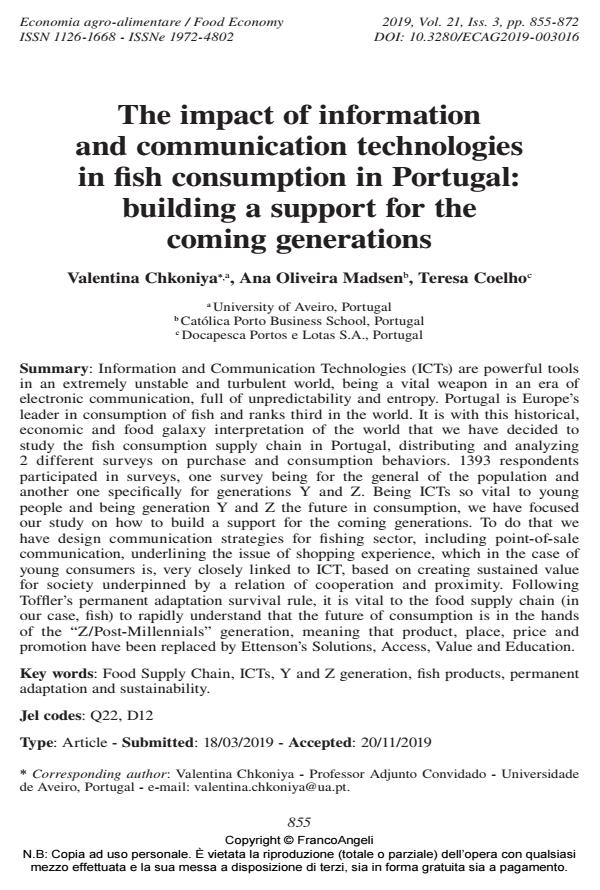The impact of information and communication technologies in fish consumption in Portugal: building a support for the coming generations
Titolo Rivista ECONOMIA AGRO-ALIMENTARE
Autori/Curatori Valentina Chkoniya, Ana Oliveira Madsen, Teresa Coelho
Anno di pubblicazione 2020 Fascicolo 2019/3
Lingua Inglese Numero pagine 18 P. 855-872 Dimensione file 150 KB
DOI 10.3280/ECAG2019-003016
Il DOI è il codice a barre della proprietà intellettuale: per saperne di più
clicca qui
Qui sotto puoi vedere in anteprima la prima pagina di questo articolo.
Se questo articolo ti interessa, lo puoi acquistare (e scaricare in formato pdf) seguendo le facili indicazioni per acquistare il download credit. Acquista Download Credits per scaricare questo Articolo in formato PDF

FrancoAngeli è membro della Publishers International Linking Association, Inc (PILA)associazione indipendente e non profit per facilitare (attraverso i servizi tecnologici implementati da CrossRef.org) l’accesso degli studiosi ai contenuti digitali nelle pubblicazioni professionali e scientifiche
Information and Communication Technologies (ICTs) are powerful tools in an extremely unstable and turbulent world, being a vital weapon in an era of electronic communication, full of unpredictability and entropy. Portugal is Europe’s leader in consumption of fish and ranks third in the world. It is with this historical, economic and food galaxy interpretation of the world that we have decided to study the fish consumption supply chain in Portugal, distributing and analyzing 2 different surveys on purchase and consumption behaviors. 1393 respondents participated in surveys, one survey being for the general of the population and another one specifically for generations Y and Z. Being ICTs so vital to young people and being generation Y and Z the future in consumption, we have focused our study on how to build a support for the coming generations. To do that we have design communication strategies for fishing sector, including point-of-sale communication, underlining the issue of shopping experience, which in the case of young consumers is, very closely linked to ICT, based on creating sustained value for society underpinned by a relation of cooperation and proximity. Following Toffler’s permanent adaptation survival rule, it is vital to the food supply chain (in our case, fish) to rapidly understand that the future of consumption is in the hands of the "Z/Post-Millennials" generation, meaning that product, place, price and promotion have been replaced by Ettenson’s Solutions, Access, Value and Education.
Parole chiave:Food Supply Chain, ICTs, Y and Z generation, fish products, permanent adaptation and sustainability.
Jel codes:Q22, D12
- Anthropological Approaches to Understanding Consumption Patterns and Consumer Behavior Teresa Coelho, Valentina Chkoniya, Ana Oliveira Madsen, Carlos Figueiredo, pp.1 (ISBN:9781799831150)
- Anthropological Approaches to Understanding Consumption Patterns and Consumer Behavior Giorgi Antadze, pp.359 (ISBN:9781799831150)
- Anthropological Approaches to Understanding Consumption Patterns and Consumer Behavior Manuel Luiz, pp.66 (ISBN:9781799831150)
Valentina Chkoniya, Ana Oliveira Madsen, Teresa Coelho, The impact of information and communication technologies in fish consumption in Portugal: building a support for the coming generations in "ECONOMIA AGRO-ALIMENTARE" 3/2019, pp 855-872, DOI: 10.3280/ECAG2019-003016